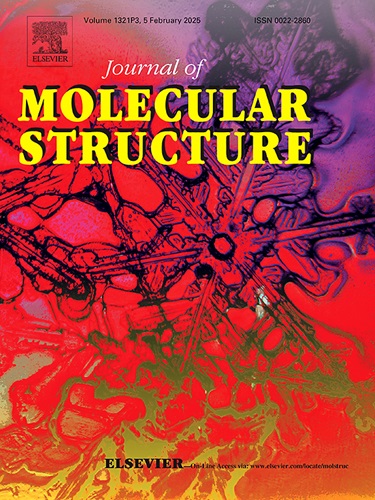设计具有不同辅助配体的基于异喹啉的橙色发光Ir(III)配合物用于溶液处理的oled
IF 4
2区 化学
Q2 CHEMISTRY, PHYSICAL
引用次数: 0
摘要
以3-(6-甲氧基萘-2-酰基)异喹啉为主配体,2-吡啶羧酸和联吡啶为辅助配体,成功合成了两种新型中性和离子型磷光铱(III)配合物Ir1和Ir2。这两种配合物分别在555 nm和609 nm处发出明亮的橙色和红色磷光,具有良好的溶解性和稳定的光物理性质,适合用溶液法制备有机发光二极管(oled)。然后,将它们结合到基于求解法的oled设计和制造中。只有基于Ir1的橙色器件表现出最佳的电致发光性能,其最大亮度、电流效率(CE)、功率效率(PE)和最大外量子效率(EQE)分别为2330 cd/m2、20.33 cd/A、3.87 lm/W和7.20%。研究结果表明,微调辅助配体可以显著影响发光性能,为设计高效oled提供了新的机会。本文章由计算机程序翻译,如有差异,请以英文原文为准。
Designing isoquinoline-based orange emissive Ir(III) complexes featuring different auxiliary ligands for solution-processed OLEDs
Two novel neutral and ionic phosphorescent iridium(III) complexes (Ir1 and Ir2) were successfully synthesized using 3-(6-methoxynaphthalen-2-yl)isoquinoline as the main ligand and 2-pyridinecarboxylic acid and bipyridine as auxiliary ligands. The two complexes exhibited bright orange and red phosphorescence emissions at 555 and 609 nm, respectively, demonstrating excellent solubility and stable photophysical properties, which is suitable to prepare organic light-emitting diodes (OLEDs) by solution method. Then, they were incorporated into the design and fabrication of OLEDs based on solution method. Only the orange device based on Ir1 showed the optimal electroluminescence performance with maximum brightness, current efficiency (CE), power efficiency (PE), and maximum external quantum efficiency (EQE) of 2330 cd/m2, 20.33 cd/A, 3.87 lm/W, and 7.20 %, respectively. The findings highlight that fine-tuning the auxiliary ligands can significantly impact the emission properties, offering new opportunities for the design of highly efficient OLEDs.
求助全文
通过发布文献求助,成功后即可免费获取论文全文。
去求助
来源期刊

Journal of Molecular Structure
化学-物理化学
CiteScore
7.10
自引率
15.80%
发文量
2384
审稿时长
45 days
期刊介绍:
The Journal of Molecular Structure is dedicated to the publication of full-length articles and review papers, providing important new structural information on all types of chemical species including:
• Stable and unstable molecules in all types of environments (vapour, molecular beam, liquid, solution, liquid crystal, solid state, matrix-isolated, surface-absorbed etc.)
• Chemical intermediates
• Molecules in excited states
• Biological molecules
• Polymers.
The methods used may include any combination of spectroscopic and non-spectroscopic techniques, for example:
• Infrared spectroscopy (mid, far, near)
• Raman spectroscopy and non-linear Raman methods (CARS, etc.)
• Electronic absorption spectroscopy
• Optical rotatory dispersion and circular dichroism
• Fluorescence and phosphorescence techniques
• Electron spectroscopies (PES, XPS), EXAFS, etc.
• Microwave spectroscopy
• Electron diffraction
• NMR and ESR spectroscopies
• Mössbauer spectroscopy
• X-ray crystallography
• Charge Density Analyses
• Computational Studies (supplementing experimental methods)
We encourage publications combining theoretical and experimental approaches. The structural insights gained by the studies should be correlated with the properties, activity and/ or reactivity of the molecule under investigation and the relevance of this molecule and its implications should be discussed.
 求助内容:
求助内容: 应助结果提醒方式:
应助结果提醒方式:


